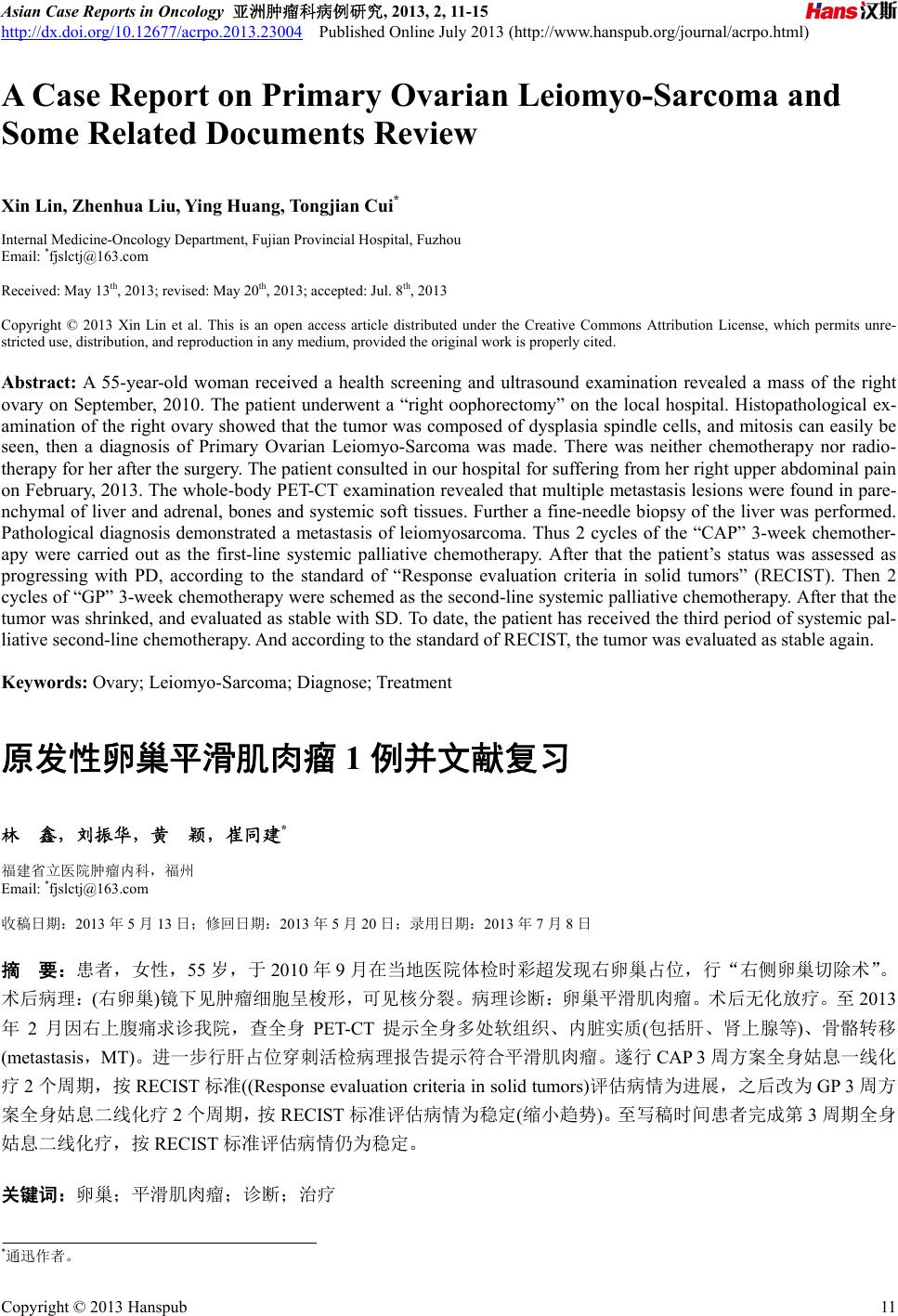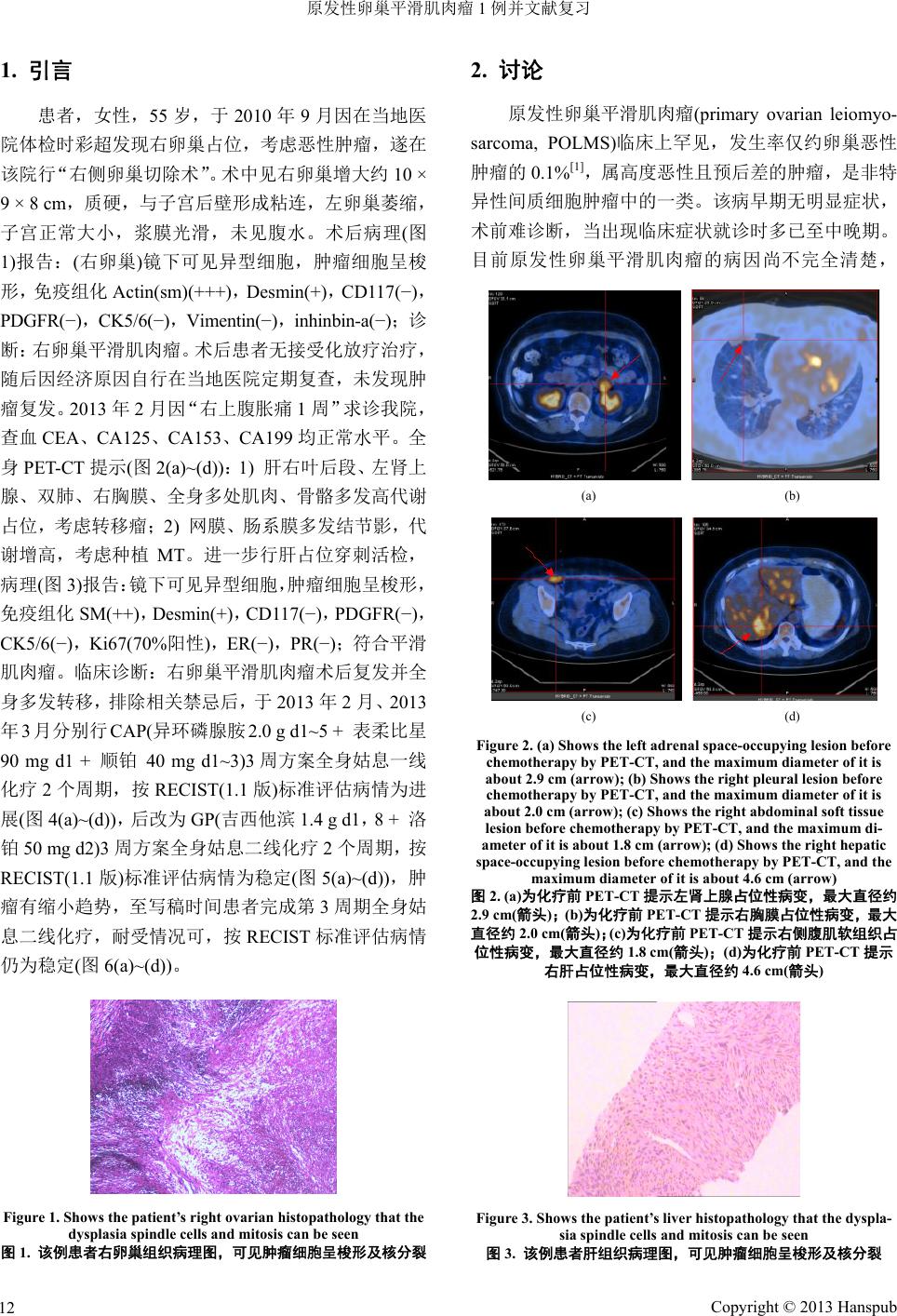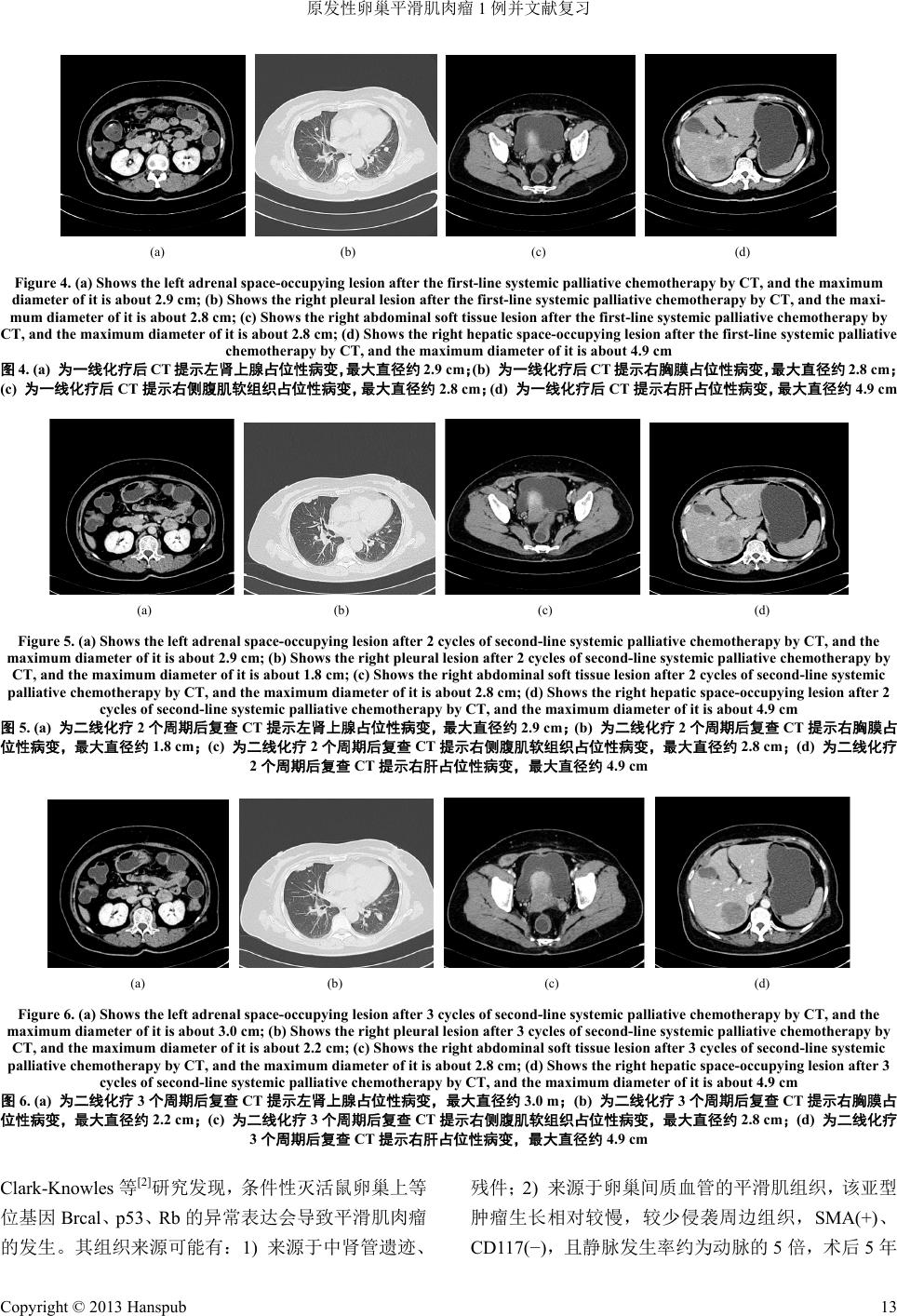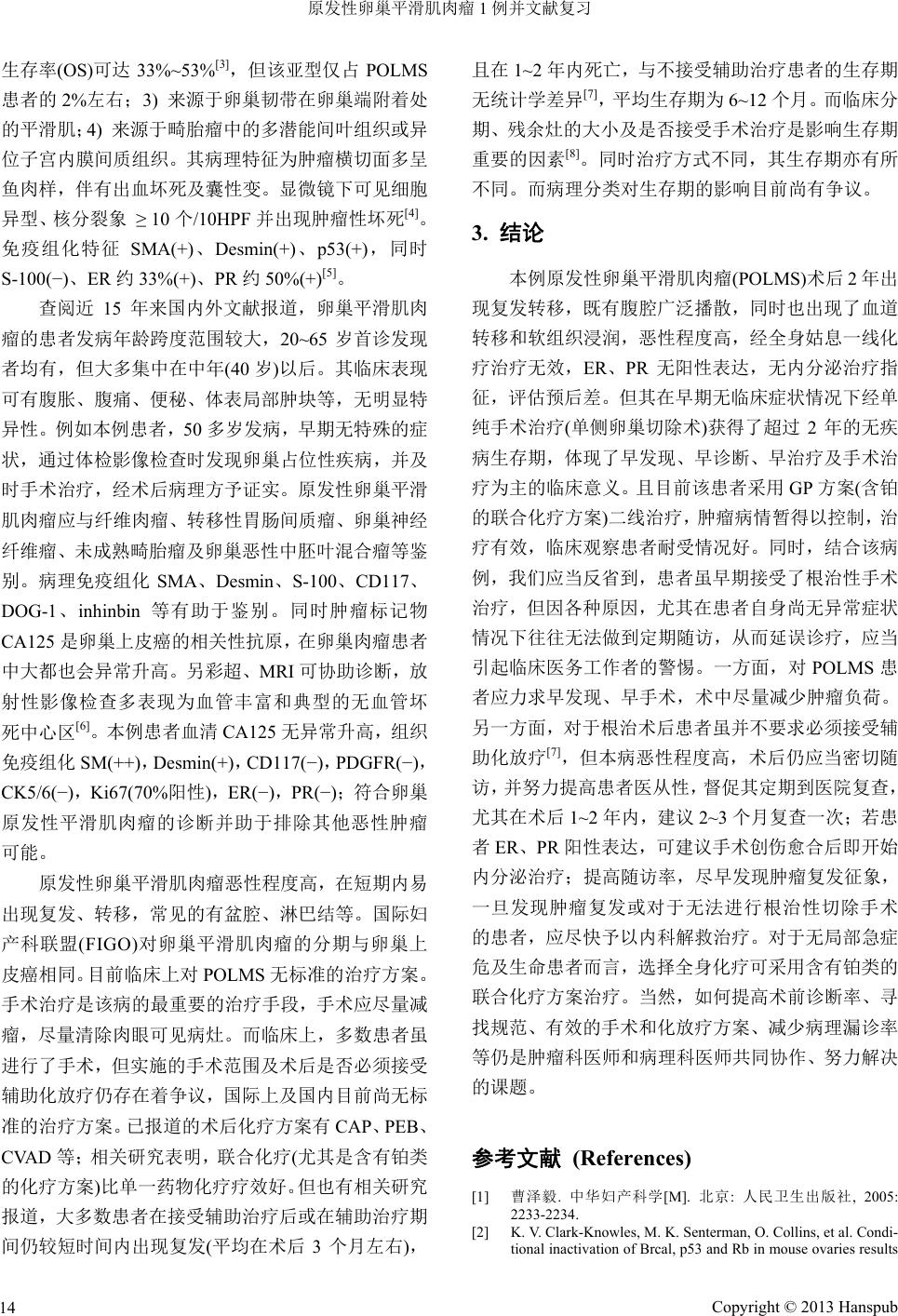 Asian Case Reports in Oncology 亚洲肿瘤科病例研究, 2013, 2, 11-15 http://dx.doi.org/10.12677/acrpo.2013.23004 Published Online July 2013 (http://www.hanspub.org/journal/acrpo.html) A Case Report on Primary Ovarian Leiomyo-Sarcoma and Some Related Documents Review Xin Lin, Zhenhua Liu, Ying Huang, Tongjian Cui* Internal Medicine-Oncology Department, Fujian Provincial Hospital, Fuzhou Email: *fjslctj@163.com Received: May 13th, 2013; revised: May 20th, 2013; accepted: Jul. 8th, 2013 Copyright © 2013 Xin Lin et al. This is an open access article distributed under the Creative Commons Attribution License, which permits unre- stricted use, distribution, and reproduction in any medium, provided the original work is properly cited. Abstract: A 55-year-old woman received a health screening and ultrasound examination revealed a mass of the right ovary on September, 2010. The patient underwent a “right oophorectomy” on the local hospital. Histopathological ex- amination of the right ovary showed that the tumor was composed of dysplasia spindle cells, and mitosis can easily be seen, then a diagnosis of Primary Ovarian Leiomyo-Sarcoma was made. There was neither chemotherapy nor radio- therapy for her after the surgery. The patient consulted in our hospital for suffering from her right upper abdominal pain on February, 2013. The whole-body PET-CT examination revealed that multiple metastasis lesions were found in pare- nchymal of liver and adrenal, bones and systemic soft tissues. Further a fine-needle biopsy of the liver was performed. Pathological diagnosis demonstrated a metastasis of leiomyosarcoma. Thus 2 cycles of the “CAP” 3-week chemother- apy were carried out as the first-line systemic palliative chemotherapy. After that the patient’s status was assessed as progressing with PD, according to the standard of “Response evaluation criteria in solid tumors” (RECIST). Then 2 cycles of “GP” 3-week chemotherapy were schemed as the second-line systemic palliative chemotherapy. After that the tumor was shrinked, and evaluated as stable with SD. To date, the patient has received the third period of systemic pal- liative second-line chemotherapy. And according to the standard of RECIST, the tumor was evaluated as stable again. Keywords: Ovary; Leiomyo-Sarcoma; Diagnose; Treatment 原发性卵巢平滑肌肉瘤 1例并文献复习 林 鑫,刘振华,黄 颖,崔同建* 福建省立医院肿瘤内科,福州 Email: *fjslctj@163.com 收稿日期:2013 年5月13 日;修回日期:2013年5月20 日;录用日期:2013 年7月8日 摘 要:患者,女性,55岁,于 2010年9月在当地医院体检时彩超发现右卵巢占位,行“右侧卵巢切除术”。 术后病理:(右卵巢)镜下见肿瘤细胞呈梭形,可见核分裂。病理诊断:卵巢平滑肌肉瘤。术后无化放疗。至2013 年2月因右上腹痛求诊我院,查全身 PET-CT提示全身多处软组织、内脏实质(包括肝、肾上腺等)、骨骼转移 (metastasis,MT)。进一步行肝占位穿刺活检病理报告提示符合平滑肌肉瘤。遂行 CAP 3 周方案全身姑息一线化 疗2个周期,按RECIST 标准((Response evaluation criteria in solid tumors)评估病情为进展,之后改为GP 3周方 案全身姑息二线化疗2个周期,按 RECIST标准评估病情为稳定(缩小趋势)。至写稿时间患者完成第3周期全身 姑息二线化疗,按RECIST 标准评估病情仍为稳定。 关键词:卵巢;平滑肌肉瘤;诊断;治疗 *通迅作者。 Copyright © 2013 Hanspub 11  原发性卵巢平滑肌肉瘤 1例并文献复习 Copyright © 2013 Hanspub 12 2. 讨论 1. 引言 原发性卵巢平滑肌肉瘤(primary ovarian leiomyo- sarcoma, POLMS)临床上罕见,发生率仅约卵巢恶性 肿瘤的 0.1%[1],属高度恶性且预后差的肿瘤,是非特 异性间质细胞肿瘤中的一类。该病早期无明显症状, 术前难诊断,当出现临床症状就诊时多已至中晚期。 目前原发性卵巢平滑肌肉瘤的病因尚不完全清楚, 患者,女性,55岁,于 2010年9月因在当地医 院体检时彩超发现右卵巢占位,考虑恶性肿瘤,遂在 该院行“右侧卵巢切除术”。术中见右卵巢增大约10 × 9 × 8 cm,质硬,与子宫后壁形成粘连,左卵巢萎缩, 子宫正常大小,浆膜光滑,未见腹水。术后病理(图 1)报告:(右卵巢)镜下可见异型细胞,肿瘤细胞呈梭 形,免疫组化Actin(sm)(+++),Desmin(+),CD117(−), PDGFR(−),CK5/6(−),Vimentin(−),inhinbin-a(−);诊 断:右卵巢平滑肌肉瘤。术后患者无接受化放疗治疗, 随后因经济原因自行在当地医院定期复查,未发现肿 瘤复发。2013 年2月因“右上腹胀痛1周”求诊我院, 查血 CEA、CA125、CA153、CA199均正常水平。全 身PET-CT 提示(图2(a)~(d)):1) 肝右叶后段、左肾上 腺、双肺、右胸膜、全身多处肌肉、骨骼多发高代谢 占位,考虑转移瘤;2) 网膜、肠系膜多发结节影,代 谢增高,考虑种植 MT。进一步行肝占位穿刺活检, 病理(图3)报告:镜下可见异型细胞,肿瘤细胞呈梭形, 免疫组化 SM(++),Desmin(+),CD117(−),PDGF R(−), CK5/6(−),Ki67(70%阳性),ER(−),PR(−);符合平滑 肌肉瘤。临床诊断:右卵巢平滑肌肉瘤术后复发并全 身多发转移,排除相关禁忌后,于 2013年2月、2013 年3月分别行 CAP(异环磷腺胺 2.0 g d1~5 + 表柔比星 90 mg d1 + 顺铂 40 mg d1~3)3周方案全身姑息一线 化疗 2个周期,按RECIST(1.1版)标准评估病情为进 展(图4(a)~(d)),后 改 为GP(吉西他滨1.4 g d1,8 + 洛 铂50 mg d2)3 周方案全身姑息二线化疗 2个周期,按 RECIST(1.1 版)标准评估病情为稳定(图5(a)~(d)),肿 瘤有缩小趋势,至写稿时间患者完成第3周期全身姑 息二线化疗,耐受情况可,按RECIST 标准评估病情 仍为稳定(图6(a)~(d))。 (a) (b) (c) (d) Figure 2. (a) Shows the left adrenal space-occupying lesion before chemotherapy by PET-CT, and the maximum diameter of it is about 2.9 cm (arrow); (b) Shows the right pleural lesion before chemotherapy by PET-CT, and the maximum diameter of it is about 2.0 cm (arrow); (c) Shows the right abdominal soft tissue lesion before chemotherapy by PET-CT, and the maximum di- ameter of it is about 1.8 cm (arrow); (d) Shows the right hepatic space-occupying lesion before chemotherapy by PET-CT, and the maximum diameter of it is about 4.6 cm (arrow) 图2. (a)为化疗前 PET-CT 提示左肾上腺占位性病变,最大直径约 2.9 cm(箭头);(b)为化疗前 PET-CT 提示右胸膜占位性病变,最大 直径约 2.0 cm(箭头);(c)为化疗前 PET-CT 提示右侧腹肌软组织占 位性病变,最大直径约 1.8 cm(箭头);(d)为化疗前 PET-CT 提示 右肝占位性病变,最大直径约 4.6 cm(箭头) Figure 1. Shows the patient’s right ovarian histopathology that the dysplasia spindle cells and mitosis can be seen Figure 3. Shows the patient’s liver histopathology that the dyspla- sia spindle cells and mitosis can be seen 图1. 该例患者右卵巢组织病理图,可见肿瘤细胞呈梭形及核分裂 图3. 该例患者肝组织病理图,可见肿瘤细胞呈梭形及核分裂  原发性卵巢平滑肌肉瘤 1例并文献复习 (a) (b) (c) (d) Figure 4. (a) Shows the left adrenal space-occupying lesion after the first-line systemic palliative chemotherapy by CT, and the maximum diameter of it is about 2.9 cm; (b) Shows the right pleural lesion after the first-line systemic palliative chemotherapy by CT, and the maxi- mum diameter of it is about 2.8 cm; (c) Shows the right abdominal soft tissue lesion after the first-line systemic palliative chemotherapy by CT, and the maximum diameter of it is about 2.8 cm; (d) Shows the right hepatic space-occupying lesion after the first-line systemic palliative chemotherapy by CT, and the maximum diameter of it is about 4.9 cm 图4. (a) 为一线化疗后 CT 提示左肾上腺占位性病变,最大直径约2.9 cm;(b) 为一线化疗后 CT 提示右胸膜占位性病变,最大直径约 2.8 cm; (c) 为一线化疗后 CT 提示右侧腹肌软组织占位性病变,最大直径约 2.8 cm;(d) 为一线化疗后 CT 提示右肝占位性病变,最大直径约 4.9 cm (a) (b) (c) (d) Figure 5. (a) Shows the left adrenal space-occupying lesion after 2 cycles of second-line systemic palliative chemotherapy by CT, and the maximum diameter of it is about 2.9 cm; (b) Shows the right pleural lesion after 2 cycles of second-line systemic palliative chemotherapy by CT, and the maximum diameter of it is about 1.8 cm; (c) Shows the right abdominal soft tissue lesion after 2 cycles of second-line systemic palliative chemotherapy by CT, and the maximum diameter of it is about 2.8 cm; (d) Shows the right hepatic space-occupying lesion after 2 cycles of second-line systemic palliative chemotherapy by CT, and the maximum diameter of it is about 4.9 cm 图5. (a) 为二线化疗 2个周期后复查 CT 提示左肾上腺占位性病变,最大直径约 2.9 cm;(b) 为二线化疗 2个周期后复查 CT 提示右胸膜占 位性病变,最大直径约 1.8 cm;(c) 为二线化疗 2个周期后复查 CT 提示右侧腹肌软组织占位性病变,最大直径约2.8 cm;(d) 为二线化疗 2个周期后复查CT 提示右肝占位性病变,最大直径约 4.9 cm (a) (b) (c) (d) Figure 6. (a) Shows the left adrenal space-occupying lesion after 3 cycles of second-line systemic palliative chemotherapy by CT, and the maximum diameter of it is about 3.0 cm; (b) Shows the right pleural lesion after 3 cycles of second-line systemic palliative chemotherapy by CT, and the maximum diameter of it is about 2.2 cm; (c) Shows the right abdominal soft tissue lesion after 3 cycles of second-line systemic palliative chemotherapy by CT, and the maximum diameter of it is about 2.8 cm; (d) Shows the right hepatic space-occupying lesion after 3 cycles of second-line systemic palliative chemotherapy by CT, and the maximum diameter of it is about 4.9 cm 图6. (a) 为二线化疗 3个周期后复查 CT 提示左肾上腺占位性病变,最大直径约3.0 m;(b) 为二线化疗 3个周期后复查 CT 提示右胸膜占 位性病变,最大直径约 2.2 cm;(c) 为二线化疗 3个周期后复查 CT 提示右侧腹肌软组织占位性病变,最大直径约2.8 cm;(d) 为二线化疗 3个周期后复查CT 提示右肝占位性病变,最大直径约 4.9 cm Clark-Knowles 等[2]研究发现,条件性灭活鼠卵巢上等 位基因 Brcal、p53、Rb 的异常表达会导致平滑肌肉瘤 的发生。其组织来源可能有:1) 来源于中肾管遗迹、 残件;2) 来源于卵巢间质血管的平滑肌组织,该亚型 肿瘤生长相对较慢,较少侵袭周边组织,SMA(+)、 CD117(−),且静脉发生率约为动脉的5倍,术后 5年 Copyright © 2013 Hanspub 13  原发性卵巢平滑肌肉瘤 1例并文献复习 生存率(OS)可达 33%~53%[3],但该亚型仅占 POLMS 患者的 2%左右;3) 来源于卵巢韧带在卵巢端附着处 的平滑肌;4) 来源于畸胎瘤中的多潜能间叶组织或异 位子宫内膜间质组织。其病理特征为肿瘤横切面多呈 鱼肉样,伴有出血坏死及囊性变。显微镜下可见细胞 异型、核分裂象 ≥ 10 个/10HPF 并出现肿瘤性坏死[4]。 免疫组化特征 SMA(+)、Desmin(+)、p53(+),同时 S-100(−)、ER 约33%(+)、PR 约50%(+)[5]。 查阅近 15年来国内外文献报道,卵巢平滑肌肉 瘤的患者发病年龄跨度范围较大,20~65 岁首诊发现 者均有,但大多集中在中年(40 岁)以后。其临床表现 可有腹胀、腹痛、便秘、体表局部肿块等,无明显特 异性。例如本例患者,50多岁发病,早期无特殊的症 状,通过体检影像检查时发现卵巢占位性疾病,并及 时手术治疗,经术后病理方予证实。原发性卵巢平滑 肌肉瘤应与纤维肉瘤、转移性胃肠间质瘤、卵巢神经 纤维瘤、未成熟畸胎瘤及卵巢恶性中胚叶混合瘤等鉴 别。病理免疫组化 SMA、Desmin、S-100、CD117、 DOG-1、inhinbin 等有助于鉴别。同时肿瘤标记物 CA125 是卵巢上皮癌的相关性抗原,在卵巢肉瘤患者 中大都也会异常升高。另彩超、MRI可协助诊断,放 射性影像检查多表现为血管丰富和典型的无血管坏 死中心区[6]。本例患者血清CA125 无异常升高,组织 免疫组化 SM(++),Desmin(+),CD117(−),PDGFR(−), CK5/6(−),Ki67(70%阳性),ER(−),PR(−);符合卵巢 原发性平滑肌肉瘤的诊断并助于排除其他恶性肿瘤 可能。 原发性卵巢平滑肌肉瘤恶性程度高,在短期内易 出现复发、转移,常见的有盆腔、淋巴结等。国际妇 产科联盟(FIGO)对卵巢平滑肌肉瘤的分期与卵巢上 皮癌相同。目前临床上对POLMS 无标准的治疗方案。 手术治疗是该病的最重要的治疗手段,手术应尽量减 瘤,尽量清除肉眼可见病灶。而临床上,多数患者虽 进行了手术,但实施的手术范围及术后是否必须接受 辅助化放疗仍存在着争议,国际上及国内目前尚无标 准的治疗方案。已报道的术后化疗方案有CAP、PEB、 CVAD等;相关研究表明,联合化疗(尤其是含有铂类 的化疗方案)比单一药物化疗疗效好。但也有相关研究 报道,大多数患者在接受辅助治疗后或在辅助治疗期 间仍较短时间内出现复发(平均在术后3个月左右), 且在 1~2 年内死亡,与不接受辅助治疗患者的生存期 无统计学差异[7],平均生存期为 6~12个月。而临床分 期、残余灶的大小及是否接受手术治疗是影响生存期 重要的因素[8]。同时治疗方式不同,其生存期亦有所 不同。而病理分类对生存期的影响目前尚有争议。 3. 结论 本例原发性卵巢平滑肌肉瘤(POLMS)术后2年出 现复发转移,既有腹腔广泛播散,同时也出现了血道 转移和软组织浸润,恶性程度高,经全身姑息一线化 疗治疗无效,ER、PR无阳性表达,无内分泌治疗指 征,评估预后差。但其在早期无临床症状情况下经单 纯手术治疗(单侧卵巢切除术)获得了超过 2年的无疾 病生存期,体现了早发现、早诊断、早治疗及手术治 疗为主的临床意义。且目前该患者采用GP 方案(含铂 的联合化疗方案)二线治疗,肿瘤病情暂得以控制,治 疗有效,临床观察患者耐受情况好。同时,结合该病 例,我们应当反省到,患者虽早期接受了根治性手术 治疗,但因各种原因,尤其在患者自身尚无异常症状 情况下往往无法做到定期随访,从而延误诊疗,应当 引起临床医务工作者的警惕。一方面,对 POLMS 患 者应力求早发现、早手术,术中尽量减少肿瘤负荷。 另一方面,对于根治术后患者虽并不要求必须接受辅 助化放疗[7],但本病恶性程度高,术后仍应当密切随 访,并努力提高患者医从性,督促其定期到医院复查, 尤其在术后1~2 年内,建议2~3 个月复查一次;若患 者ER、PR 阳性表达,可建议手术创伤愈合后即开始 内分泌治疗;提高随访率,尽早发现肿瘤复发征象, 一旦发现肿瘤复发或对于无法进行根治性切除手术 的患者,应尽快予以内科解救治疗。对于无局部急症 危及生命患者而言,选择全身化疗可采用含有铂类的 联合化疗方案治疗。当然,如何提高术前诊断率、寻 找规范、有效的手术和化放疗方案、减少病理漏诊率 等仍是肿瘤科医师和病理科医师共同协作、努力解决 的课题。 参考文献 (References) [1] 曹泽毅. 中华妇产科学[M]. 北京: 人民卫生 出版社, 2005: 2233-2234. [2] K. V. Clark-Knowles, M. K. Senterman, O. Collins, et al. Condi- tional inactivation of Brcal, p53 and Rb in mouse ovaries results Copyright © 2013 Hanspub 14  原发性卵巢平滑肌肉瘤 1例并文献复习 Copyright © 2013 Hanspub 15 in the development of leiomyosarcomas. PLoS One, 2009, 4(12): e8534. [3] M. Chiarugi, E. Pressi, R. Mancini, et al. Leiomyosarcoma of the right ovarian vein. The American Journal of Surgery, 2009, 197(4): e36-e37. [4] 陈乐真. 妇产科诊断病理学[M]. 2版, 北京: 人民军医出版社, 2010: 423. [5] S. Taskin, E. A. Taskin, N. Uzum, et al. Primary ovarian leio- myosarcoma: A review of the clinical and immunohistochemical features of the rare tumor. Obstetrical & Gynecological Survey, 2007, 62(7): 480-486. [6] S. H. Kim, H. J. Kwon, J. H. Cho, et al. Atypical radiological features of a leiomyosarcoma that arose from the ovarian vein and mimicked a vascular tumor. British Journal of Radiology, 2010, 83(989): e95-e97. [7] 陈晨, 沈铿, 冯凤 芝. 原发性卵巢平滑肌肉瘤诊断和治疗(附 2例报告)[J]. 实用妇产科杂志, 2001, 17(1): 40-41. [8] A. K. Sood, J. I. Sorosky, M. S. Gelder, et al. Primary ovarian sarcoma.Cancer, 1998, 82(1): 731-737. |